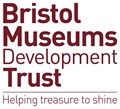Story
What is BMDT?
Bristol Museums Development Trust was established in 2008 as an independent charity to raise funds for all visitor sites and museums - including Bristol Museum and Art Gallery, collections, learning, and the many other activities undertaken by Bristol Museums and Archives.
Bristol Museum & Art Gallery cares for one of the most significant natural sciences collections in the UK, with an estimated 1.35 million specimens collected from Bristol and beyond since the 1700s.
As described below, their collections have a significant impact on our city and beyond; culturally, socially and economically. Whilst Bristol Museums are generously supported by both Bristol City Council and Arts Council England, they still have to raise just over 40% of their funding. If you are able to join with me and support this vital work, both myself, Bristol Museums, and Bristol as a natural environment will be grateful for your support.
Why butterflies?
Butterflies are aerial ambassadors that enrich our lives and act as vital visible indicators of the health of our own environment. Included in this Natural History Collection is an incredible, vast collection of preserved butterflies. The team are keen to share photographs of them along with their historic distribution data; to reveal the people, places, and times behind each carefully collected specimen.
The wider climate perspective
Being able to understand historic distribution and activity of butterfly species gives us an understanding of how our environment has changed. Enabling brilliant researchers from across the world to have open, free access to Bristol Museum's collection will have an immense impact on our overall scientific capability to conduct research on how the climate has changed, and potentially find new, innovative ways to prevent this change.
This collection is invaluable in piecing together the British butterflies’ early distributions and abundance. Studying and understanding the collection can help us understand general threats to biodiversity or inform pathways to conservation. This collection may hold the key information needed to unlock fundamental answers to the scientific and societal challenges of our time:
- How do we conserve the biodiversity on which both our own well-being and our planet's health depend on?
- How do both academic and creative individuals explore this data in new, exciting, and valuable ways?
The challenge ahead
At present, this vital information is hidden away within the butterfly specimens and labels; not in the public domain. Bristol Museums want to undertake the monumental, but paramount task of cataloguing and sharing this information digitally: for free, to everyone.
To understand and share the baseline data out of our collection will help provide evidence of the changes in biodiversity and climate that have occurred. Essentially we want to unlock this treasure trove so that everyone, including citizen scientists, researchers and data analysts, can access it. We believe that everybody deserves a right to access this evergreen resource.
Sadly, this incredible journey is vastly under-resourced. If this project required passion and dedication alone, we would've been done by now. We still, however, have some large hurdles to overcome in terms of financing specialist equipment and skilled personnel to bring us to completion.
Why should I donate?
By donating, you're supporting the sharing of this invaluable data, and supporting the heart of new climate and biodiversity research. You become an important cornerstone of our natural history.
Thank you sincerely for giving up your time in reading this. I firmly and truly believe in granting the world a profound insight into the workings of the butterfly species, and hope that this project inspires others to create, learn, and become passionate new scientists and artists.
Thank you for your contribution,
Solomon Gilbert and Bristol Museums Development Trust
